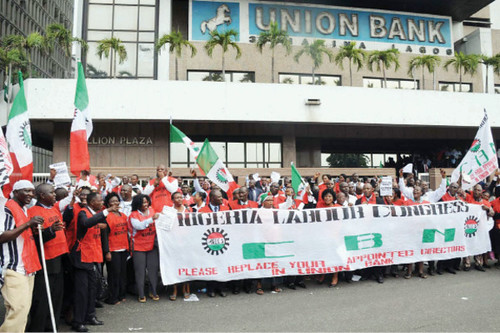
The Nigeria Labour Congress has vowed to picket Union Bank branches over a dispute involving the recognition of the labour organization. The NLC represents large numbers of workers across Africa's most populous state., a photo by Pan-African News Wire File Photos on Flickr.
Nigeria’s Oil and Gas – jobs, jobs, jobs, for the jobless
Wednesday, 27 July 2011 00:00 Godwin J. Igwe
Nigerian Business Day
Dear Mr. President, distinguished members of the Nigeria National Assembly and Senate (NASS), and the Nigerian National Press: Time waits for nobody, and four years will soon come and go.
Please consider this my proposal and contribution to some of the other ideas you will no doubt be receiving, regarding the joblessness of Nigerian citizens.
A long view of legacy is needed for sober and temperate analysis of the problem facing our country. This aforementioned problem is not something that has not visited this world before.
For a blueprint of an effective solution, I humbly suggest that you attempt to implement what the United States President, Franklin Roosevelt, did during his First 100 days of office. He created an employment program that formed the engine of the infrastructure-directed economic recovery that led the American nation out of the Great Depression.
The program built 650,000 miles of roads, 78,000 bridges, 125,000 civilian and military buildings, 800 airports (built or improved), and 700 miles of airport runways.
It also served almost 900 million hot lunches to school children, and operated 1,500 nursery schools. It presented 225,000 concerts to audiences totaling 150 million people, performed plays and circuses before another 30 million, and created 475,000 works of art.
Some of Roosevelt’s “New Deal” popular landmarks dot the country to this day, and serve as a living testimony of his legacy: La Guardia Airport in New York; the River Walk in San Antonio, Texas; Camp David in Maryland; and the Cow Palace in San Francisco.
The Works Progress Administration’s (WPA) primary mission was to repair the nation’s roads and mid-sized infrastructure.
In so doing, it linked rural America with the cities, and refurbished everything from military bases to educational facilities. It can be said, with no exaggeration, that without the WPA, the U.S. could not have carried out a successful war mobilization.
By employing eight million Americans, coupled with thirty million dependents, the program brought people renewed hope and courage. It maintained and increased their working skills, while simultaneously enabling them, once again, to take their rightful places in public and private employment.
In his inaugural address, Roosevelt declared war on The Depression, challenging the nation to overcome its fears. He also moved to immediately put people back to work, stating:
“This nation asks for action, and action now. This is no unsolvable problem if we face it wisely and courageously. It can be accomplished in part by direct recruiting by the government itself, treating the task as we would treat the emergency of a war, but at the same time accomplishing greatly needed projects to stimulate and reorganize the use of our natural resources.”
President Jonathan, President of the Federal Republic of Nigeria (POTFRON), can do better than even Obama, President of the United States (POTUS). The strategy behind Obama’s stimulus bill resembles that of the WPA.
Like the stimulus, the WPA tackled unemployment indirectly by spending money largely through private contractors. The WPA was led by one Harold Ickes Sr., who had a very cautious-to-a-fault management style, resulting in only $110 million of the program’s authorized $3.3 billion getting spent during the program’s crucial first year.
Frustrated, Roosevelt employed Harry Hopkins (who led CWA – Civil Works Administration), to help get unemployed workers through the coming winter by putting them directly onto the federal payroll.
In contrast, Obama pledged that the stimulus package would “save or create 3 to 4 million jobs over the next few years.” (His budget director estimated that 75 percent of the money would be spent within 18 months).
In contrast, Hopkins got there within two months. So the bottom line is this, and cannot be understated: who President Jonathan assigns this task to is crucial.
CWA spent $1 billion, and its workforce built or improved over 500,000 miles of roads, as well as built or repaired 40,000 schools and 3,700 playgrounds. It also restored all the city parks in New York, laid 12 million feet of sewer pipe, built 250,000 privies, while starting or upgrading 1,000 airports across the country.
Again, CWA did all of this in four months. Did this break the bank? By no means. In fact, the investment increased the productivity of the economy as a whole, and yielded more “payback” to the economy (including through taxes) than it required to execute.
Of the nearly $1 billion that Hopkins spent during the CWA’s five-month existence (the equivalent today of nearly $16 billion), 80 percent went directly into workers’ pockets, and thus stimulated the economy by going into the cash registers of grocers and shop owners. Most of the rest went into equipment costs, and less than 2 percent paid for administration.
President Roosevelt did so many more good things for the ordinary citizens of America that space and time do not permit me to elaborate on.
2 comments:
Thanks so much for sharing these intelligent piece with us.
How I also wish you could link us up to better jobs sites
allot are really in pains, modern day slavery for a job
If you are Looking for a international Job specially Nigerian people must check it Oil and Gas Career opportunities
Be intelligent and be aware in any other case bogus recruitment agencies can consider you for any journey.
Gas jobs
Post a Comment